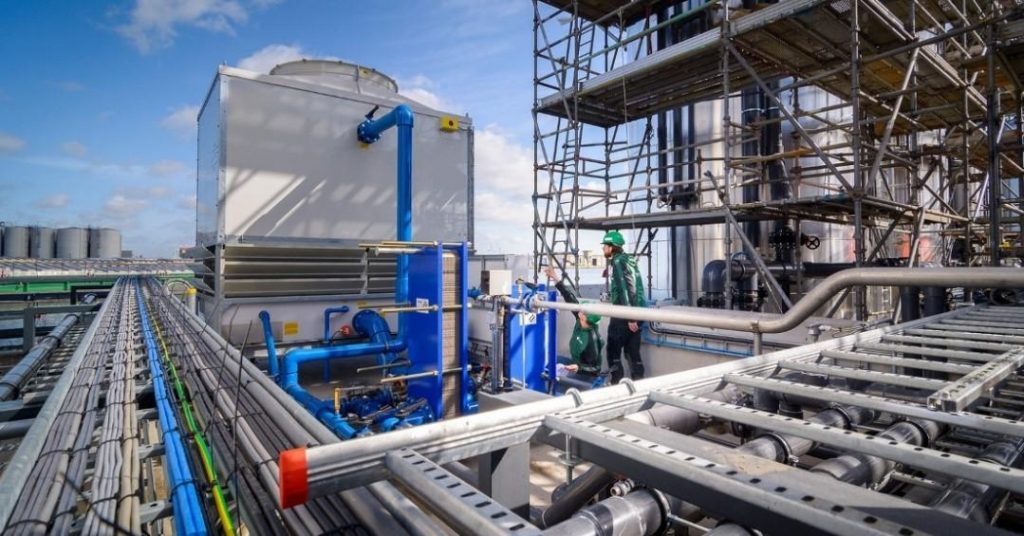
COOLING TOWERS: WHAT ARE THEY AND HOW DO THEY WORK
COOLING TOWERS GUIDE
All industrial facilities, as well as those for air conditioning or refrigeration or energy production are characterised, by heat emissions: these are more or less significant in quantitative terms. Usually this “residual” heat has a low energy content that does not make its recovery possible or worthwhile. Therefore it must somehow be dissipated externally.
Among the various solutions available for this purpose, in this article we will be looking at cooling towers: they are recognised today as among the most efficient technologies available on the market.
- What are cooling towers, what are they used for, and how do they work?
- What does ‘evaporative’ mean?
- What components and materials are used in cooling towers?
- What types of cooling towers are there?
- Where and why are they used? Industrial and civil applications.
- What are purges and contributions in cooling towers?
- How to maintain and treat cooling water?
EVAPORATIVE COOLING TOWERS: WHAT THEY ARE AND WHERE THEY ARE USEFUL
Evaporative cooling towers, or cooling towers are devices which make use of a natural principle which is as simple as it is effective: the forced evaporation of a minimum quantity of water, compared to the main mass, which when performing the phase change “steals” energy from the unevaporated water flow (latent heat of evaporation).
The process by which evaporative cooling occurs is as simple as it is ancient: the archaic amphorae made of terracotta, a porous material, allowed the water to leach outwards in minimal quantities. In this way, an evaporative process took place: the water inside was kept cool even in high ambient temperatures.
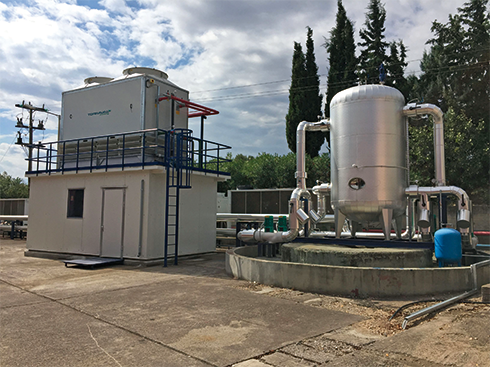
A COMPARISON OF COOLING TECHNOLOGIES: EVAPORATIVE, DRY, ADIABATIC AND MECHANICAL COOLERS
In selecting an industrial or civilian refrigeration system, operating temperatures and environmental conditions are considered. Options include:
Dry Coolers: Cool ambient air, achieving minimum temperatures of 5 ºC above ambient.
Adiabatic Systems: Combine air and water evaporation, achieving temperatures similar to ambient.
Cooling Towers: Efficient for large quantities of water, reaching 3 ºC above the wet bulb.
Chillers: For extremely low temperatures, with high electrical consumption.
There is no cooling system that is suitable for all conditions. The choice should be based on specific design requirements and environmental conditions, seeking to optimize energy consumption and space efficiency.
COOLING TOWERS: SIZING AND COMPONENTS
How to size a tower: the importance of the wet bulb temperature
The size of an evaporative tower is determined by a few fundamental parameters. These include:
- the thermal power to be dissipated;
- the temperature of the water entering the tower;
- the output temperature to be achieved;
- the thermo-hygrometric conditions (i.e. temperature and humidity) of the installation area.
This information especially is a decisive factor in determining the correct size. It makes it possible to identify that exact parameter of the wet bulb temperature which, as we have seen, defines the “worst” environmental conditions in the place of installation and the minimum temperature that the water cooled by the evaporative tower is likely to achieve.
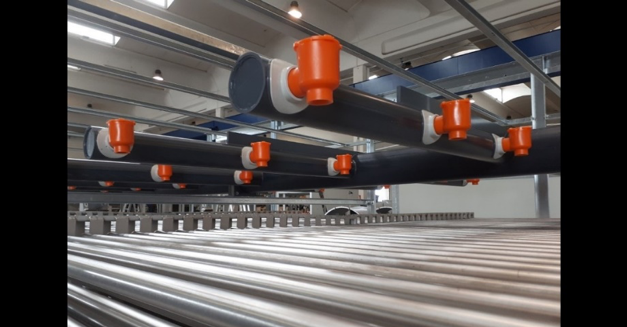
Components of cooling towers and the materials used
- Principal containment and support structure for the evaporative tower: this can be made of sheet metal, fibreglass or both materials. For extremely large industrial or hyperbolic towers, cement is also used.
- Heat exchange surface (in open circuit towers) or heat exchange coil.
- Axial or centrifugal fans: this is the only moving mechanical part and is the component that “forces” the water evaporation required to achieve cooling. The choice of an axial or centrifugal fan, depending on the design conditions, is important in order to achieve the most efficient operation and the lowest energy consumption of the system. Let’s look at the criteria.
- Water distribution system, normally consists of ramp of pipes and nozzles. It makes it possible to distribute the water to be cooled over the heat exchange surface (open circuit cooling towers) or on the exchange coil
(closed circuit cooling towers). - Drift eliminator, located immediately upstream of the fan. It serves to retain the water droplets, which would otherwise be carried outside by the flow of air caused by the fan.
Cooling towers are divided into several types:
Evaporative and non-evaporative: The former cool by evaporation of water, while the latter use other mechanisms.
Open and closed circuit: In the open circuit, the water is in direct contact with the air; in the closed circuit, the water circulates inside a coil without direct contact.
Natural and mechanical draft: Natural draft uses air density differences, and mechanical draft uses fans.
Adiabatic and hybrid: Adiabatic units minimize water consumption, and hybrid units combine air and evaporative cooling.
How to choose the right cooling solution.
We now come to the different types and construction variants of cooling towers: during the design phase, the choice is based on the application for which they are intended, or on the size of the plant.
The most frequent variables which can affect the choice are mainly the following:
- thermal power to be dissipated,
- nature of the water to be cooled,
- process type,
- context within which installation takes place (civil or industrial),
- particular plant requirements, for example, if it is a new system or a replacement.
COOLING TOWERS: MAIN INDUSTRIAL AND CIVIL APPLICATIONS
As indicated at the beginning, cooling towers are widely used in evaporation systems:
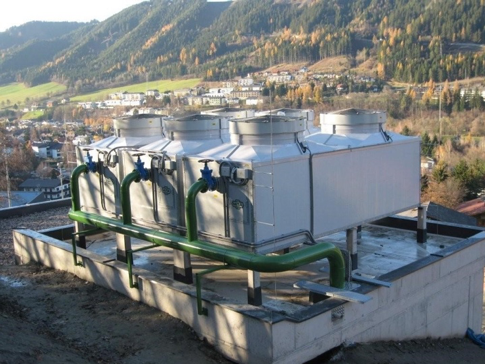
Like all devices within a technological system, evaporative cooling towers, of whatever type, also require a routine maintenance programme and, in the event of a failure, an extraordinary maintenance program.
Because of the extreme simplicity of construction, cooling towers do not require particular attention, apart from the observance of some very simple and effective guidelines to ensure they are always kept in optimum operating conditions.
In fact, safety and efficiency go hand in hand.
A clean evaporative tower means an evaporative tower which is always efficient, therefore able to offer maximum efficiency with minimum consumption, both in terms of electricity and evaporated and purged water.
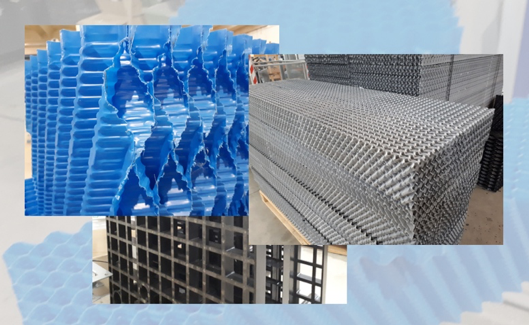
Good practices provided by a tower manufacturer
Obviously, the components that make up the evaporative tower also benefit from correct management: the heat exchange surfaces have a longer life, just as the motors and fans work in better conditions thanks to the less aggressive water that can cause a deterioration of the most sensitive parts.
With regard to the practices to be followed to obtain this condition, it is generally sufficient to comply with the specific indications provided by the Manufacturer regarding periodic checks and maintenance, as well as the physical-chemical parameters to be observed for the water in circulation. However, there are more general guidelines, often also mentioned in the Manufacturer’s manuals, which provide “good practices” valid for all systems where evaporative cooling towers are used: prestigious bodies in this sense include Eurovent, Cooling Technology Institute, Assoclima (Confindustria).
These are useful impartial suggestions for optimal running of the entire system.